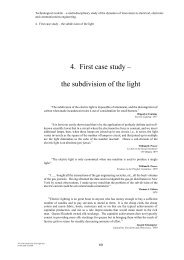Valuation Techniques for Social Cost-Benefit Analysis: - HM Treasury
Valuation Techniques for Social Cost-Benefit Analysis: - HM Treasury
Valuation Techniques for Social Cost-Benefit Analysis: - HM Treasury
Create successful ePaper yourself
Turn your PDF publications into a flip-book with our unique Google optimized e-Paper software.
40<br />
illusion. Instead, respondents are simply asked to provide a subjective assessment of their overall<br />
well-being which is then matched with objective measures of the determinants of well-being<br />
and their exposure to the non-market good. Using panel data we can track the effects of a nonmarket<br />
good over time and there<strong>for</strong>e fully estimate the degree of adaptation. Furthermore,<br />
people are not required to have perfect in<strong>for</strong>mation about the good being valued and there is<br />
no (hypothetical) payment involved and so this solves <strong>for</strong> the problems related to the payment<br />
vehicle in stated preference techniques.<br />
If variables are measured accurately, increased consumption of a non-market good or service<br />
should show up in changes in well-being and thus values, there<strong>for</strong>e reducing the risk of<br />
insensitivity to scope. Although it has not been tested empirically, sub-additivity and sequencing<br />
effects should also logically disappear. The resulting value estimate will be calculated on the<br />
basis of how people are actually affected by the good over time.<br />
Finally, since the analyst in effect calculates the marginal rates of substitution between income<br />
and the non-market good there is no potential <strong>for</strong> errors to occur due to people‘s inability to<br />
convert subjective feelings and beliefs into a monetary scale.<br />
On the other hand, we have highlighted that contextual factors can have large effects on<br />
people‘s reported well-being and there may be biases inherent to the way that people report<br />
their well-being to the surveyor. This means that reported measures of well-being may be pick<br />
up highly irrelevant factors which would bias any estimated statistical relationship between life<br />
satisfaction and the variable of interest, say income or employment.<br />
The life satisfaction approach typically involves conducting econometric analysis in order to<br />
estimate the true causal effect of both income and the non-market good of interest on reported<br />
life satisfaction. For a number of reasons outlined above this is extremely challenging and often<br />
requires rich data sets and careful econometric analysis. Many of the valuations which have been<br />
generated so far are implausibly high. Most of the reasons <strong>for</strong> this are likely to have been<br />
addressed in this chapter. The approach is still very much in development in the academic<br />
literature.<br />
The robustness of a valuation generated by a given study using any of the three valuation<br />
methods, and there<strong>for</strong>e the appropriateness of including it in <strong>Social</strong> <strong>Cost</strong>-<strong>Benefit</strong> <strong>Analysis</strong>,<br />
should always be assessed on a case-by-case basis. However, given the relative infancy of<br />
approaches that utilise reports of life satisfaction to derive valuations, we suggest relatively more<br />
caution be exercised regarding this method. Instead, we recommend that the life satisfaction<br />
approach to valuation be currently regarded as a complement to the more standard preferencebased<br />
approaches, especially where good data on life satisfaction are available.<br />
Nevertheless, even when the valuations derived from a specific life satisfaction study cannot be<br />
considered robust enough <strong>for</strong> <strong>Social</strong> <strong>Cost</strong>-<strong>Benefit</strong> <strong>Analysis</strong> due to the reasons outlined here, the<br />
valuations and their description can still be of value. It is likely that the study may still be able to<br />
indicate the approximate magnitude of an impact thereby allowing decision makers to refine the<br />
values that they may otherwise place implicitly on these impacts.





![AIRTO [Professor Dr Brian Blunden] - HM Treasury](https://img.yumpu.com/15492848/1/184x260/airto-professor-dr-brian-blunden-hm-treasury.jpg?quality=85)










